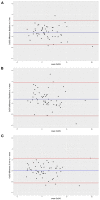The Cone of Direct Gaze: A Stable Trait
- PMID: 34267708
- PMCID: PMC8275972
- DOI: 10.3389/fpsyg.2021.682395
The Cone of Direct Gaze: A Stable Trait
Abstract
Direct eye gaze is a potent stimulus in social interactions and is often associated with interest and approach orientation. Yet, there is remarkable variability in the range of gaze lines that people accept as being direct. A measure that is frequently used to quantify the range of gaze angles within which an observer assumes mutual gaze is the cone of direct gaze (CoDG). While individual differences in CoDG have often been examined, studies that systematically investigate the stability of an observers' CoDG over time are scarce. In two experiments, we measured the CoDG using an established paradigm and repeated the measurement after 5 min and/or after 1 week. We found high inter-individual variation, but high agreement within participants (ICCs between 0.649 and 0.855). We conclude that the CoDG can be seen as a rather stable measure, much like a personality trait.
Keywords: Bland–Altman plot; CoDG; cone of gaze; direct gaze; individual differences; stability.
Copyright © 2021 Lobmaier, Savic, Baumgartner and Knoch.
Conflict of interest statement
The authors declare that the research was conducted in the absence of any commercial or financial relationships that could be construed as a potential conflict of interest.
Figures





References
-
- Argyle M., Cook M. (1976). Gaze and Mutual Gaze. New York, NY: Cambridge University Press.
-
- Baron-Cohen S. (1995). Mindblindness: An Essay on Autism and Theory of Mind. Cambridge, MA: The MIT Press.
LinkOut - more resources
Full Text Sources

